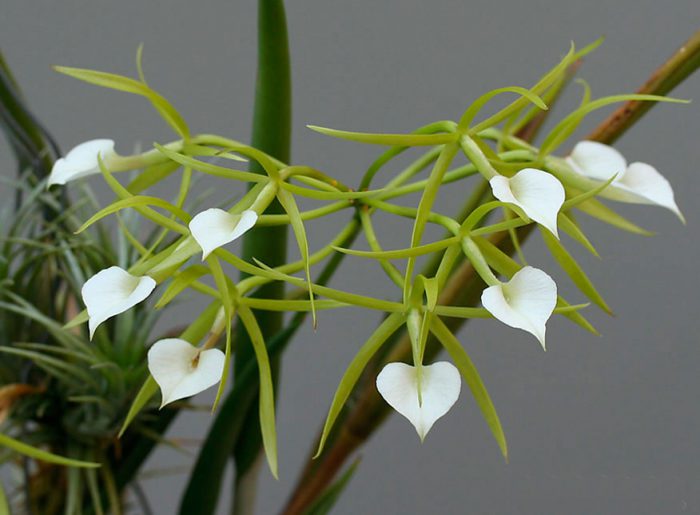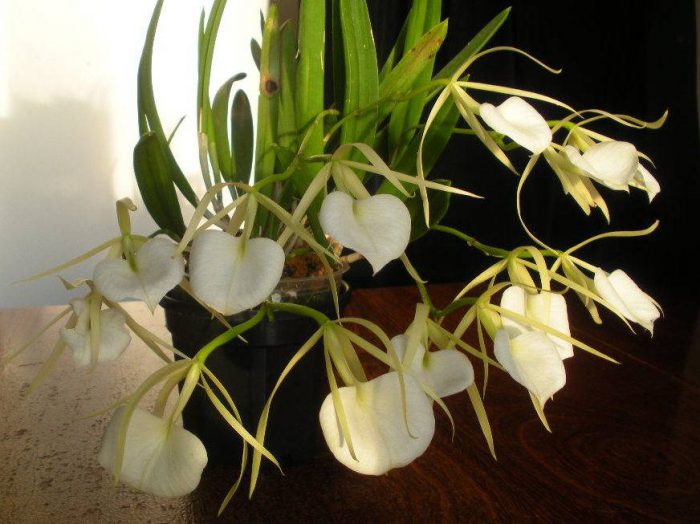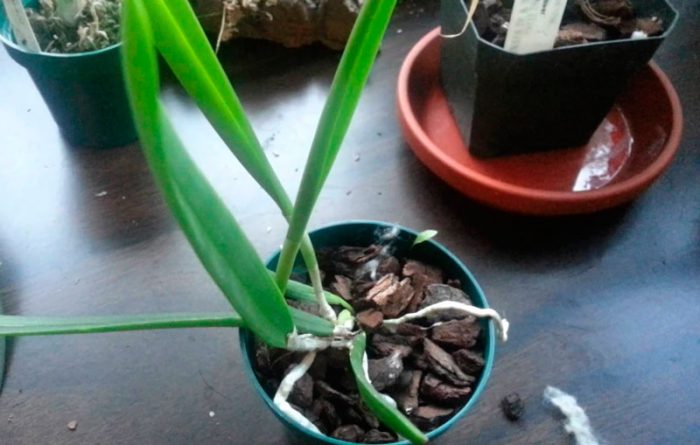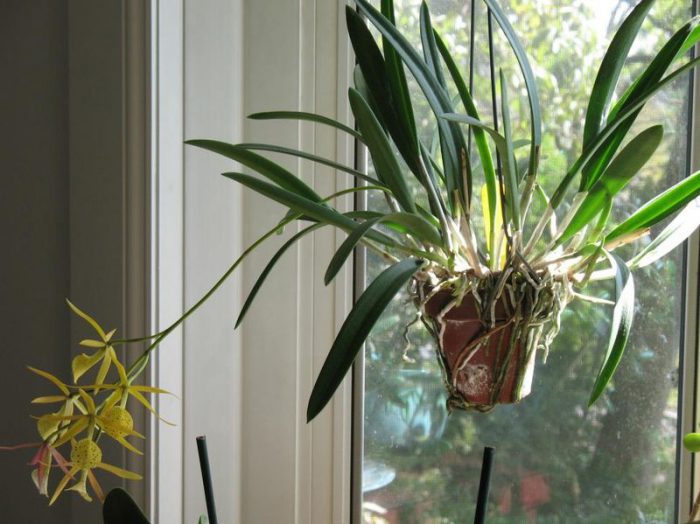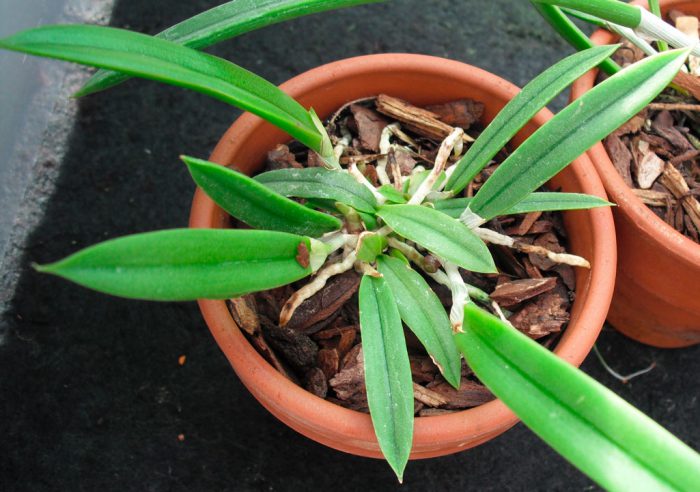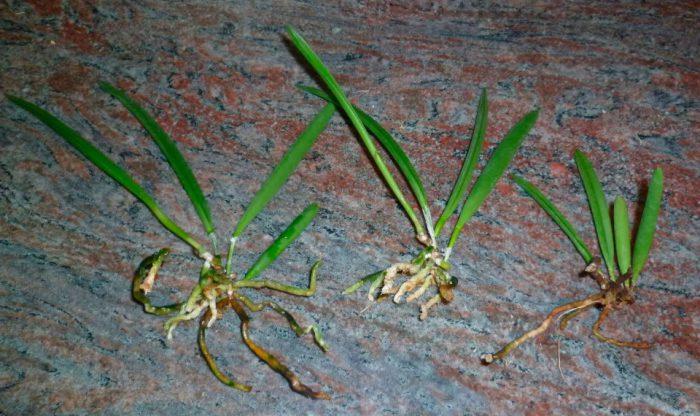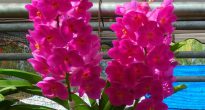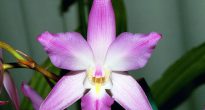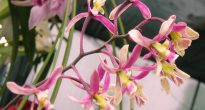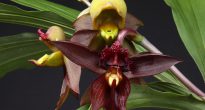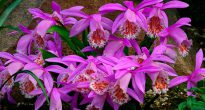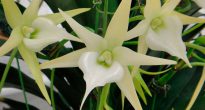Few genus brassavola (Brassavola) is directly related to the orchid family. This genus unites about 20 plant species, represented by lithophytes and epiphytes. In nature, they can be found in Central and South America.
Has a sympoidal growth pattern. So, new shoots grow at the base of old ones, while the growth occurs along the rhizome (a modified creeping shoot). In this case, the old pseudobulbs are gradually dying off. Cylindrical pseudobulbs are 10 to 15 centimeters long and 0.5 to 1.5 centimeters wide. They have a clear resemblance to bare, rather thick shoots that make their way through the leathery membrane. It dries out over time and turns into a wrapper case. At the top of each pseudobulb there is a fleshy, rather rigid leaflet (sometimes 2 or 3), colored dark green and having a pointed tip. In length, such leaves reach 5–30 centimeters and are somewhat wider than the pseudobulbs themselves. Lanceolate-belt-shaped leaves are concave or folded along the central vein.
The small-flowered inflorescence in the form of a brush consists of 1–6 fragrant flowers of a rather large size. These inflorescences carry lateral or apical peduncles, which are thin and rather long. The flowers are pronounced zygomorphic. 3 sepals (sepals) in relation to each other are located at an angle of 120 degrees, petals (petals) are opposite lying. There is also a lip (3rd modified petal), which is quite large. At the base, it is rolled into a narrow, rather long tube, and then unfolds with a wide fan shaped like a heart or a triangle. Sepals and petals are very similar in shape and color. They are narrow-lanceolate and white-green or white-yellow in color. In this case, the lip is often painted in pure white and has a speck of green or yellow at the base.
Depending on the type, flowers can last from 5 to 30 days.

This genus of orchids is not yet very popular among domestic florists. So, the most widespread species today is the brassavola nodosa (Brassavola nodosa). This species is known for its rather strong aroma at night, because of this, such a flower is also called "Lady Night". The length of pseudobulbs can be from 6 to 8 centimeters, with 3 or 4 internodes, as well as 1 greenish-gray leaf. The leaf is about 30 centimeters long and 1.5 centimeters wide. The diameter of the color of the glasses is about 9 centimeters, but there are specimens with larger flowers (about 15 centimeters).Narrow (0.5 centimeters wide) petals and sepals in length can reach from 4 to 7 centimeters. They have a linear lanceolate shape and are colored light green. The heart-shaped lip has the same width and length equal to 4 centimeters. Blooming is observed in winter and spring.
Content
Caring for the brassavola orchid at home
A plant such as brassavola knotty is suitable for growing by both experienced growers and beginners. And all because she is relatively uncaptious and undemanding to care for.
Illumination
He loves light very much and he needs the direct rays of the evening and morning sun. However, on hot summer days, the plant needs shading from the direct midday scorching rays of the sun. Otherwise, rather severe burns can form on the surface of pseudobulbs and foliage, which are represented by brown-brown spots. If there are too many burns, then this can cause the death of the brassavola.
If the plant receives an insufficient amount of light, then its young growths will be underdeveloped. As a result, flower buds cannot form. In this regard, the flowers on the north-facing windows need illumination with special phytolamps (this also applies to prolonged cloudy weather). Illumination throughout the year should be kept at a level of 20,000 to 35,000 lux, while remembering that daylight hours should be at least 10 hours. Do not forget that sufficient lighting is the key to successful flowering.
You can determine whether such an orchid of light is enough or not by the appearance of the foliage. If there is enough light, the color intensity will be normal. If there is little light, the leaves acquire a pale green tint.
Temperature regime
This plant shows a moderately warm temperature regime. And in order for it to grow and develop normally, it needs daily temperature drops. Without such differences, flower buds will not form.
In summer, daytime temperatures of 25 to 35 degrees are recommended for this orchid, and night temperatures are from 16 to 20 degrees. In winter, she will feel good during the day at temperatures from 18 to 20 degrees, and at night - from 12 to 16 degrees. It should be remembered that the room should not be colder than 12 degrees.
In the summer, experts advise to move brassavol to the street (to the balcony, to the garden). Moreover, it must be protected from gusts of wind, drafts and precipitation. Fresh air makes a mature plant bloom more abundantly. Plus, when grown outdoors, this orchid will provide a natural drop in daily temperatures.
Earth mix
Suitable for growing pots filled with substrate, as well as special blocks. The substrate should consist of pine bark (or other coniferous tree), coconut chips, sphagnum and charcoal. In this case, the components are taken in equal parts. Quite large pieces of pine bark are used as blocks (they can be replaced with wicker baskets). On the surface of the block, you need to fix the root system, and then cover it with a not very thick layer of coconut fiber or sphagnum.
How to water
The irrigation regime depends on the environmental conditions. So, in warmer rooms, the substrate dries out faster, so you need to water it more often. When grown on a block, an orchid requires daily watering, while it is carried out by immersion. So, in a basin filled with water, you need to lower the block for a third of an hour. In the same way, you need to water the flowers growing in pots. After you remove the orchid from the water, wait until all excess liquid has drained off, only then put the pot back in place.In the event of stagnation of water in the substrate, the root system will begin to rot, which may cause the flower to die.
Watering is recommended after the substrate is thoroughly dry. To do this, use well-settled, soft water, which should not contain chlorine.
Also, to stimulate the formation of flower buds, and also for hygienic purposes, a regular hot (about 40 degrees) shower is recommended for the plant.
Air humidity
What kind of air humidity the plant needs also depends on the growing conditions. A flower growing in a pot needs 55-60 percent, and on a block it needs a higher air humidity, or rather, no less than 70-75 percent. The warmer the room and the brighter the lighting, the more moisture the plant needs. However, with high humidity, systematic and fairly frequent ventilation is needed. And all because humid, warm, stagnant air contributes to the development of various fungal diseases and rot.
In order to increase humidity, experts advise using household humidifiers and steam generators. This method of humidifying the air is indispensable for orchids grown on blocks. When growing in containers, it is recommended to pour expanded clay into the pallet and pour in a little water, and to maintain the required humidity, the plant must be systematically moistened from the sprayer (in the morning and evening hours).
Pruning
Inexperienced growers often remove old wrinkled pseudobulbs, but this is wrong. The fact is that in any pseudobulbs, be they young or old, there are valuable nutrients that the flower really needs for normal development. You can only remove a completely dried pseudobulb.
Fertilizer
Since the root system is very susceptible to various chemicals and salinity, fertilizing the soil is too often unnecessary. This should be done 1 time in 3 or 4 weeks, using special fertilizers for orchids. They are dissolved in water for irrigation. The fertilizer dose should be less than the one recommended on the package. The orchid also needs foliar feeding; a fairly weak nutrient solution is used for spraying.
Transplant features
A transplant should be carried out only if absolutely necessary. So, this procedure is carried out if the root system ceases to fit into the container, or when young growths begin to crawl out of the pot. It is necessary to transplant brassavol very carefully. Especially carefully it is necessary to treat the roots, which are ingrown into the walls of the container, into the block, as well as adherent to pieces of bark. When transplanting, you should not separate the bark from the roots, they are simply placed in a new container and the substrate is poured into it. Ingrown roots should not be pulled to free them, as they can be easily damaged. If possible, cut off a piece of bark or pot into which the root has grown, using a very sharp knife or blade.
Reproduction methods
Such a plant, grown indoors, can only be propagated by separating the rhizome. It should be remembered that at least three mature pseudobulbs must be present on each cut.
Pests and diseases
Brassavola is not susceptible to diseases and pests. A fairly common problem that growers have when growing such an orchid is the lack of flowering. The reason for this may be poor lighting or incorrect temperature conditions.

